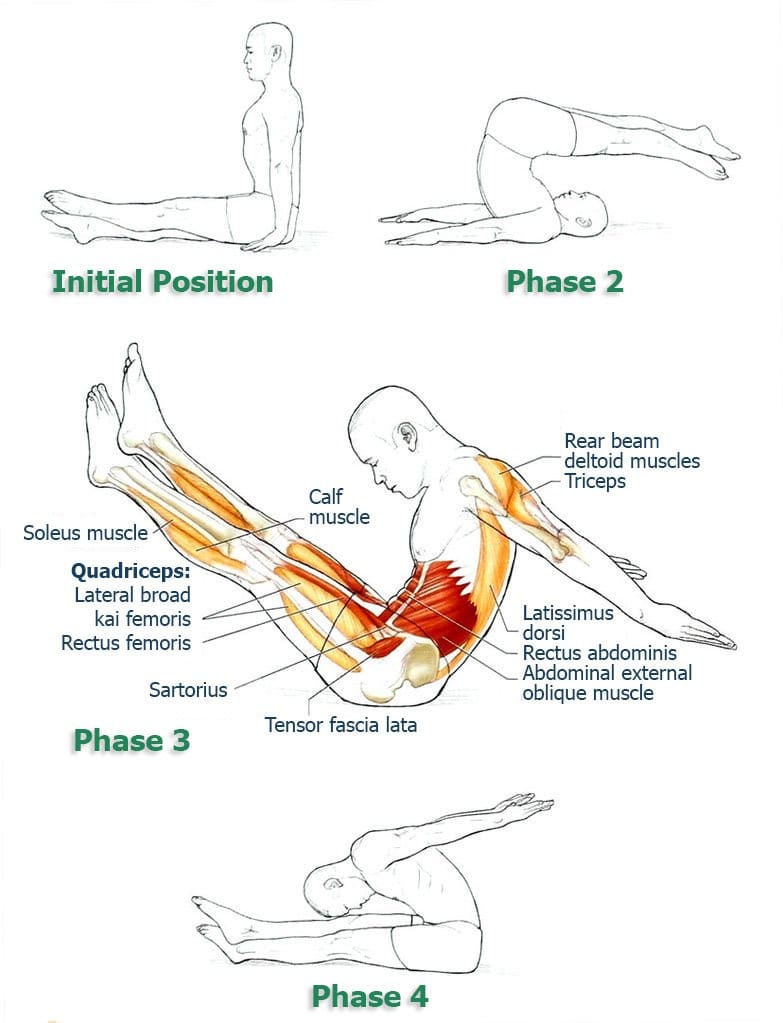In the sixth part of our program, we’ll demonstrate a very interesting exercise. Boomerang is a challenging exercise, involving many muscles, where we try to maintain a balance in the body’s movements in space. The exercise aims to improve core muscle strength and to coordinate the movement precision of your body.
The series so far:
- Exercise #1: Rolling Over
- Exercise #2: Seal
- Exercise #3: Crab
- Exercise #4: Rocking Chair
- Exercise #5: Extended Legs Back Roll
- Exercise #6: Boomerang (you are here)
- Exercise #7: Controlled Balance
- Exercise #8: Jackknife
Exercise #6: Boomerang

Initial position. Sit on the mat with straight back and legs. Put one foot on the other and cross them at the ankles. Extend your toes. The hands rest on the mat in the immediate vicinity of the pelvis:
- Breathing out, roll onto your back and bring your feet behind your head. In this phase we are working the same muscles like in Extended Legs Back Roll;
- Breathing in, roll forward, but do not lower your feet on the mat; keep them suspended at an angle. Take your hands backwards, palms facing up;
- Breathing out, bring your feet on the mat and bend your head as low as possible towards the knees. Hands are still behind;
- Breathing in, bring your straitened hands forward in a circular movement through the sides of your body;
- Breathing out, roll backwards, as described in the 2nd phase. Repeat the exercise 6 times, changing the position of the feet. After the last repetition, return to the starting position.
Make Sure You:
- Pull-in the stomach to prevent subsidence in the waist where the hip flexor muscles raise the legs off the floor and then tilt the pelvis backwards when rolling to your back in the 2nd phase of the exercise. Between the legs and torso the same constant angle must be maintained;
- At the end of phase 2, use the leg extensor muscles at the hip when you change the position the feet are held at;
- In the 3rd phase, engage your abdominal muscles to do the gradual lowering of the pelvis to the mat, and then to maintain the correct angle between the legs and torso;
- In the 4th phase, slowly lower your feet on the mat. Here the abdominal muscles prevent anterior pelvic tilt. The spine extensor muscles are also at work, controlling the forward inclination of the body;
- Throughout the exercise the legs should be straight and the toes pointed outward;
- Take your hips off the floor in the 2nd phase of the exercise, as the hands press down firmly on the mat as they also help to raise the body. Repeat in the 3rd phase as you control the lowering. In the 3rd and 4th phases, the arm extensor muscles in the shoulder joint are also used to take the arms back. During this movement, the hands are slightly turned inwards in order to engage the latissimus dorsi muscle and give the opportunity to fully straighten the elbows;
- When moving the arms from the rear position to the front in the 5th phase, shoulder muscles are activated. Throughout this movement the hands remain straight. The flexors at the shoulder joint work to slowly lower the arms to the starting position;
- Mental image – as the name suggests, imagine your body as a boomerang, not only in form, but also by the nature of the movements. Correctly thrown boomerang flies in an arc and always returns to the starting point, just like we do during the exercise.
Additional Notes
Boomerang – a complex exercise that includes maintaining a stabilizing force at the center, and maintaining a balance in the body’s movements in space. It involves many muscles, but their work is aimed not only at improving muscle strength, but also to coordinate movement precision of your back and control of the center core muscles. The aim of the exercise is dynamic stretching of the posterior group of thigh muscles, and the spine and arm extensor muscles.
Boomerang contains elements of some of the previous exercises from this series. Do not perform it until you have obtained the proper execution experience from those exercises and consult your doctor to make sure the exercise is suitable for you.
Modifications
If you lack flexibility in the posterior group of thigh muscles, you can slightly bend the knees when lifting the legs and when bending forward (3rd and 4th phases). It will be less challenging, but the movement precision of your back should still see improvements.

